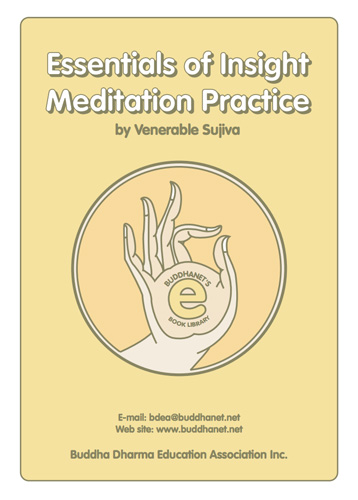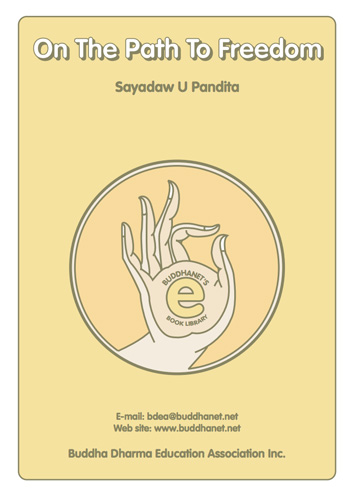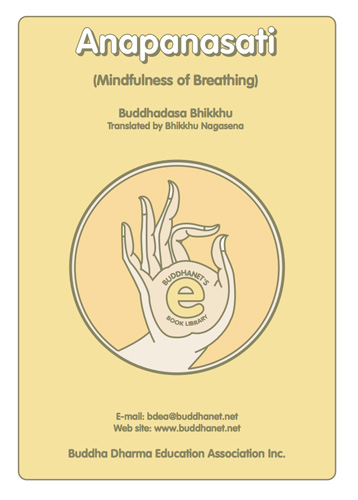 Top rated - eBook Library Top rated - eBook Library |

05_satipatthana_sutta_01.pdf01 Satipatthana Sutta3247 viewsWe have seen how different approaches to translation provide different approaches to the meditation practice itself. Translation, interpretation and practice all take place within communities. One's choices in translation is also an expression of one's identity. If I identify with a specific tradition, I will translate in a way that fits with that tradition's view of the teaching and the practice. If I refuse to identify with a tradition, preferring to go my own way or be part of the creation of a new tradition, this choice also will condition translation and interpretation. And interpretation conditions practice. The practice is defined by its texts, and the texts are formed by translation and interpretation.    
(5 votes)
|
|

thittila.pdfEssential Themes of Buddhist Lectures3149 viewsThese talks on Buddhism given by this famous Burmese Buddhist master, Venerable Sayadaw U Thittilla in the west over the period 1938-1983. Some of the themes are: 'What is Buddhism', 'Likes and Dislikes', 'A Short History of Buddhism', 'What Kamma Is', 'The Path to Nibbana' and 'The Abhidhamma Philosophy'.    
(5 votes)
|
|

bmDamaStory.pdfDhammapada Stories13391 viewsSelected verses from the Dhammapada, all depicted with thirty-two beautiful illustrations. This collection is a great introduction to the Dhammapada and has been carefully compiled and edited for the younger reader by Gambhiro Bhikkhu. [126 pages]    
(49 votes)
|
|

essentials.pdfEssentials of Insight Meditation Practice7083 viewsThe ultimate aim of insight meditation is to free one from the unsatisfactoriness of cyclic existence. Readers may also find numerous quotations of the Buddha's teaching on mindfulness, detachment and liberation throughout the entire book. Those verses act as a source of inspiration and purpose to put vipassana into practice - a practice that brings about insight into the three universal characteristics of unsatisfactoriness, impermanence and non-self which leads one into detachment and ultimate liberation.    
(13 votes)
|
|

muktipatha.pdfDhammapadam (Marathi language)19040 viewsThe Dhammapada in Marathi language.    
(24 votes)
|
|

path-free.pdfOn The Path To Freedom4555 viewsOn The Path to Freedom - a mind of wise discernment and openness - by Burmese Meditation Master, Sayadaw U Pandita. This is a compilation of Dhamma discourses to foreign meditators at the Mahasi Meditation Centre, Rangoon, Myanmar, who came to practise under him in Yangon (formerly Rangoon) between August 1986 to March 1987. Translated from Myanmar by the late Mya Thaung.    
(8 votes)
|
|

Aggregates.pdfA Burden Off the Mind: A Study Guide on the Five Aggregates7275 viewsOne of the new concepts most central to the Buddha's teaching was that of the khandhas, usually translated into English as “aggregates.†Prior to the Buddha, the Pali word khandha had very ordinary meanings: A khandha could be a pile, a bundle, a heap, a mass. It could also be the trunk of a tree. In his first sermon, though, the Buddha gave it a new, psychological meaning, introducing the term “clinging-khandhas†to summarize his analysis of the truth of stress and suffering. Throughout the remainder of his teaching career, he referred to these psychological khandhas time and again. Their importance in his teachings has thus been obvious to every generation of Buddhists ever since.    
(11 votes)
|
|

anapanasati.pdfAnapanasati - Mindfulness of Breathing13019 viewsFor the first time in the English language a comprehensive manual of Buddhist meditation known as anapanasati (the development of mindfulness of breathing) is available. Although this manual is primarily intended for the benefit of monks, it will greatly assist laymen, too, who wish to undertake a course of meditation but who do not have the guidance of a teacher. Originally published in Thai, this manual is one of the major works of the Ven. Buddhadsa Bhikkhu and delivered in 1959 in the form of a series of lectures to monks of Suanmokkha Monastery, Chaiya, Thailand. Ven. Buddhadasa Bhikkhu, a major voice in the Buddhist world, is an accepted master of Buddhist meditation. In constructive positive language, the manual guides the meditator through the 16 steps of anapanasati.    
(27 votes)
|
|

ordination.pdfOrdination Procedure3013 viewsPali / English
Ordination Procedure, was composed by Somdet Phra Sangharja Pussadeva of Wat Rajapratisahasthitamahasmarama. His Eminence reformed some of the text and procedure for Pabbajja and Upasampada from the original text. The method of Pabbajja (Going-forth) and Upasampada (Acceptance) in the Southern School (that is, Theravada) uses the original Magadha (Pali) language.    
(6 votes)
|
|

milinda.pdfThe Debate of King Milinda (The Milanda Panna)2741 viewsThe Milanda Panna is a famous work of Buddhist literature, probably compiled in the 1st century B.C. It presents Buddhist doctrine in a very attractive and memorable form as a dialogue between a Bactrian Greek king, Milinda, who plays the 'Devil's Advocate' and a Buddhist sage, Nagasena. The topics covered include most of the questions commonly asked by Westerners. This abridgement provides a concise presentation of this masterpiece of Buddhist literature.    
(6 votes)
|
|
| 290 files on 29 page(s) |
 |
 |
 |
17 |  |
 |
 |
|
